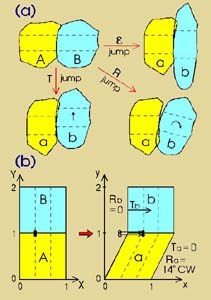| |
Grain boundary sliding is a process in which grains slide past each
other along, or in a zone immediately adjacent to, their common boundary
(Langdon and Vastava 1982). Adams and Murray (1962) first observed grain
boundary sliding in experimentally deformed bicrystals of NaCl and MgO,
where offset of scratch marker lines pre-inscribed across the grain boundary
occurred. In-situ observation of grain boundary sliding in a Zn-Al
alloy was made by Naziri et al. (1973, 1975), using electron microscopy.
They inferred grain boundary sliding from the observation of grain neighbor
switching during deformation. Considering the extensive grain boundary
migration in their photographs, however, neighbor switching alone does
not provide convincing evidence of grain boundary sliding, because neighbor
switching can be achieved by grain boundary migration only (Means and Ree,
1990; Bons and Urai, 1992).
Grain boundary sliding is a probable process in plastic flow of polycrystals
if there is deformation incompatibility among grains and if the necessary
accommodation mechanisms for grain boundary sliding can operate (see below).
Figure 1(a) shows, in a schematic way, three possible situations for grain
boundary sliding, where there is a strain jump, rotation jump, or translation
jump between grains. However strain, rotation or translation jumps do not
necessarily produce grain boundary sliding, if material at the contact
or boundary can maintain coherent contact by suitably matching deformation
of the two grains (Fig. 1b, see also Means and Jessell 1986).

Fig. 1. (a) Schematic diagram illustrating why grain boundary
sliding occurs. Top left: two grains (A & B) in the undeformed state
with two straight marker lines (broken lines). Top right: grain boundary
sliding due to a strain jump. Bottom right: grain boundary sliding due
to a rotation jump. Bottom left: grain boundary sliding due to a translation
jump. (b) Schematic diagram to show that strain, rotation or translation
jumps do not necessarily cause grain boundary sliding. Grain A is dextrally
sheared (shear strain = 0.5) while grain B is rigidly translated, inducing
a strain jump (from a maximum principal strain of about 0.28 to zero strain),
a rotation jump (from about 14o CW rotation of the principal
strain direction to zero rotation), and a translation jump (from Ta = 0
to Tb = 0.5) across the boundary from grain a to b. However, grain boundary
sliding does not occur since material particles at the boundary (black
dots) are displaced into the same positions by each domainal deformation
of the grains.
Zhang et al. (1994) have shown in a computer
modeling of fabric development that the introduction of a small amount of
grain boundary sliding sufficiently decreases ‘grain interaction’ in the
intracrystalline plastic deformation regime, and suggested that grain
boundary sliding can be a mechanism for accommodating strain
incompatibility between neighboring grains. It should be also pointed out
that grain boundary sliding has been considered a dominant deformation
mechanism in superplasticity, although the term superplasticity does not
imply or even define a particular deformation mechanism (Schmid et al.,
1977; Poirier, 1985, pp. 204-205; Gilotti and Hull, 1990). For example,
there is a general agreement that grain boundary sliding contributes more
than 50% of the total strain in superplastic materials (Vastava and
Langdon, 1979; Chokshi and Langdon, 1985; Kashyap et al., 1985). This is
the case probably when a smaller grain size and/or presence of melt or
fluid film along grain boundaries facilitate grain boundary sliding.
|
